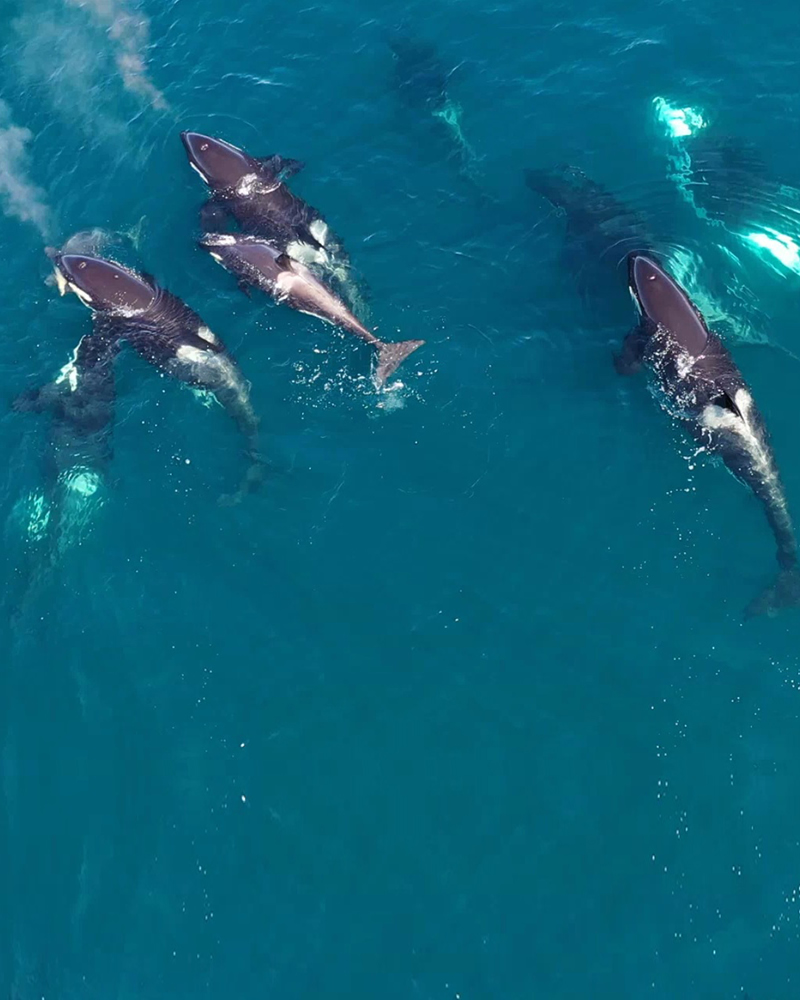




| Species Name | Brown bear |
| Japanese Name | Higuma / Ezohiguma |
| Scientific Name | Ursus arctos yesoensis |
| Height | 1.3 - 2.3m |
| Weight | Male 200 - 400kg, Female 100 - 200kg |
| Distribution | Hokkaido, Kunashir Island, Etorofu |
The Ezo brown bear is characterized by a large bulge in the shoulder muscles and longer claws on the forefoot, when compared to the Asian black bear. It is quite large and the coloration of the fur has a wide variety from light brown to black. Many people think that brown bears are carnivorous because of their appearance, but they are surprisingly omnivorous, eating more plant-based foods. For non-plants they eat ants, as a large portion of their food, additionally they also eat crayfish, other insects, and Hokkaido sika deer. Deer are often hit by cars as roadkill and bears will eat them opportunistically. As for plants, they eat Asian skunk cabbage (Lysichiton camtschatcensis), giant butterbur (Petasites japonicus), and Umbellifers (Apiaceae family, like celery & parsely). In autumn, they eat Hardy kiwi (Actinidia arguta), fruit of the crimson glory vine (Vitis coignetiae), acorns etc. Bears like anything sweet, so occasionally one will break into a beekeepers' hives or ruin corn and beet fields.
Shiretoko National Park is famous as one of the densest brown bear habitats in the world. The theory as to why so many brown bears can live in such a small area is because the diversity of habitats, ranging from coastlines to alpine zones are so concentrated. Thanks to that, it allows for a wide variety of food resources throughout the year. Even though you may not encounter a bear while hiking, you can find traces of them; From claw marks left on the trees, to dung and footprints on the ground. A thorough survey is currently underway on the abundance of brown bears on the Shiretoko Peninsula.
Typically, the end of the bear's winter slumber is around the beginning of April, but females who gave birth (from late January to early February) will leave the den about a month later. Around the beginning of May, all bears will have become active, including the single bears and mothers with cubs.
The sunny coastal slopes are often used by these bears in early spring. Here, the snow melts more quickly, and it provides a buffet of grasses that sprouted early. It is the safest season for observing brown bears nearby, if you are lucky, from a fisherman's ferry (round trip from Aidomari Port-Shiretoko Cape) or a sightseeing boat (round trip from Shari-Shiretoko Cape) where the brown bears are grazing quietly.
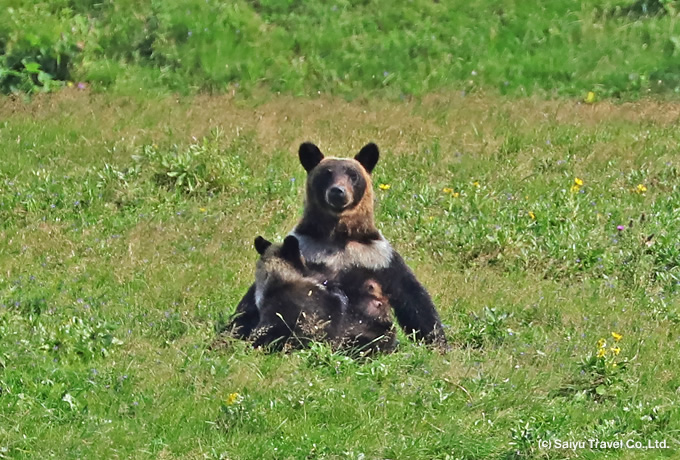 A mother bear breast-feeding her cubs (August photo)
A mother bear breast-feeding her cubs (August photo) The mating season starts just before June, and the males will roam extensively in search of encounters with multiple females. If you look carefully at the wetlands, you might be able to find a particularly large footprint of a male in pursuit of a female sow, which is quite impressive. In the summer, bears can be seen feasting on the butterbur plants along the river, but such places have very poor visibility and the sound of the river makes it difficult to hear if a bear is approaching. Therefore, there is a high possibility that you will inadvertently encounter the bears at a close range, so you will need to be extra careful.
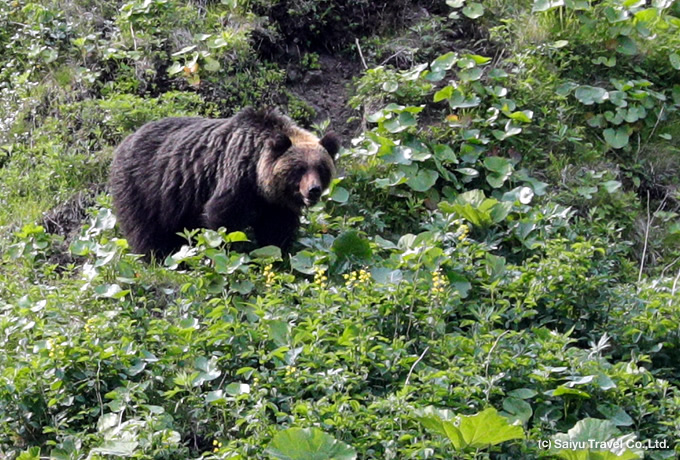 Wandering through the butterbur plants (June photo)
Wandering through the butterbur plants (June photo)The fruitful plenty of autumn. Brown bears love the acorns of the oak trees mizunara (Quercus crispula) and will eat large amounts to accumulate body fat in preparation for their long hibernation. Pink salmon and chum salmon that swim upstream for spawning are also valuable sources of protein as well. In late August, bears that have a relatively low level of fear of humans, can be seen chasing fish in the shallow water near the river estuary.
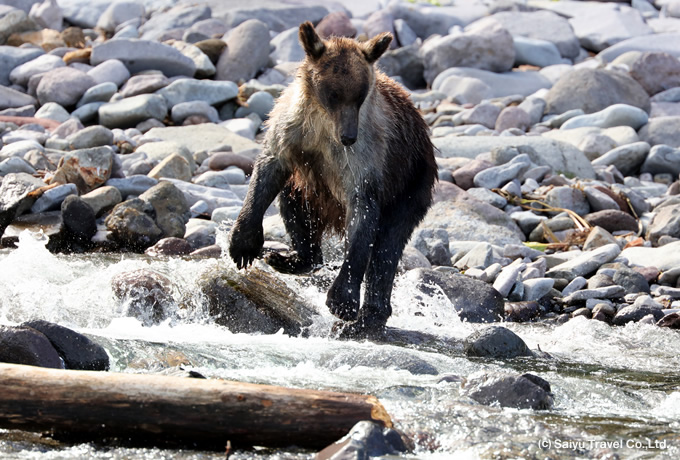 Chasing fish in the river estuary (August photo)
Chasing fish in the river estuary (August photo)Early December. Bears with plenty of nutrition will begin to dig into hibernation dens, one after another. Using a tree hollow or a rocky cave on rare occasions, most of the time, the bears will dig their own den in the soil. A bear's hibernation is a relatively light sleep so in the event of an emergency, they are still ready to react, if aroused. Therefore, even in the middle of winter, if they sense the approach of a human or feel danger, they may suddenly push the snow away and jump out. You may have an image of bears hibernating deep in the mountains at some high altitude, but many have actually been found near the coastlines and roadsides.
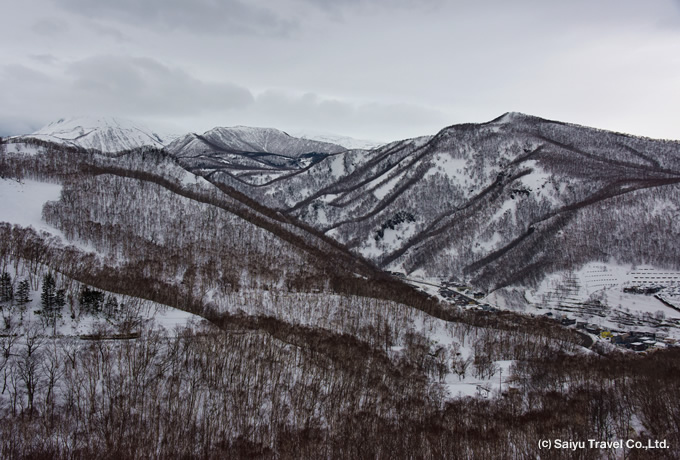 Rausu's silent winter enveloped in snow (February photo)
Rausu's silent winter enveloped in snow (February photo)When living alongside the brown bears, it is important to be aware that brown bears, which naturally avoid contact with humans, may approach us due to our own careless actions. Which may end up causing accidents that end up only hurting the bears.
There was an incident in which a bear invaded a fishing cottage, called 'Banya' in Japanese, on the Shiretoko Peninsula. The brown bear drank a large amount of canned juice that was stored in the cottage. It probably could not have smelled the juice itself, because none of them were open, but the bear had already learned that cans contain a sweet liquid. It is possible the bear learned the visual cue of the can from rummaging in trash or drinking from littered cans along the roadside. The cottage was luckily empty, so nobody was injured, but if we carelessly let them learn how to get access to our human food, it could escalate to accidents involving injury to people. Therefore, never litter so we can continue to prevent brown bears from becoming "problematic wildlife that needs to be removed." Furthermore, conservation of the bear's natural feeding grounds as well as targeted environmental awareness programs to prevent accidents (resulting in injury or death) have started in recent years, and these are also important efforts to aim for a harmonious coexistence with wild bears.


| Species Name | Subspecies of Japanese Deer, the Ezo Sika Deer |
| Japanese Name | Ezoshika |
| Scientific Name | Cervus nippon yesoensis |
| Height | 90 - 190cm |
| Weight | Male 120 - 150kg, Female 80 - 95kg |
| Distribution | All around Hokkaido |
During summer, their fur is brown with white spots. In the winter the males develop a dark brown coloration but light brown for the female does. Male deer's lifespan is only 10 years but females can live up to 20 years. The Hokkaido sika deer mainly eat herbs and leaves from broad-leaved trees, as well as the branches. They survive the harsh winter by mainly eating sasa (the broad-leaved bamboo) and tree bark. It is herbivorous and as a ruminant, has four stomachs. Most of the Shiretoko sika deer mature at 1, mating and entering gestation to give birth at the age of 2.
The Hokkaido sika deer is a subspecies of Cervus nippon, and their size is the largest of all 7 subspecies (still a topic of debate) distributed throughout Japan. About 30 years ago, an explosive increase occurred in mainly the Eastern Hokkaido region, causing many problems like damage to agriculture and forest management.
Once the snow falls, the deer start to gather in their “wintering grounds”, a low-altitude forest zone. The Shiretoko Peninsula has many steep cliffs along the coastline, which shield certain areas from the strong winds and less snow accumulates here, making it an optimal natural shelter for the deer. The slopes on the right bank of the Iwaubetsu River are popular wintering grounds, and when viewed from the opposite bank using binoculars, many deer can be seen through the trees.
Unlike in summer, the deer have their winter fur and fluffy, covered with snow. Their diet during the winter, consists mainly of bark from broad-leaved trees and the ‘Kumazasa' dwarf bamboo trees (Sasa sp.) to avoid starving. However, because these are very low in nutrients, the deer lose weight throughout the cold winter. Close to Shiretoko, the nearby Notsuke Peninsula, Lake Furen in Nemuro and Cape Nosappu are all wintering grounds for the Hokkaido sika deer.
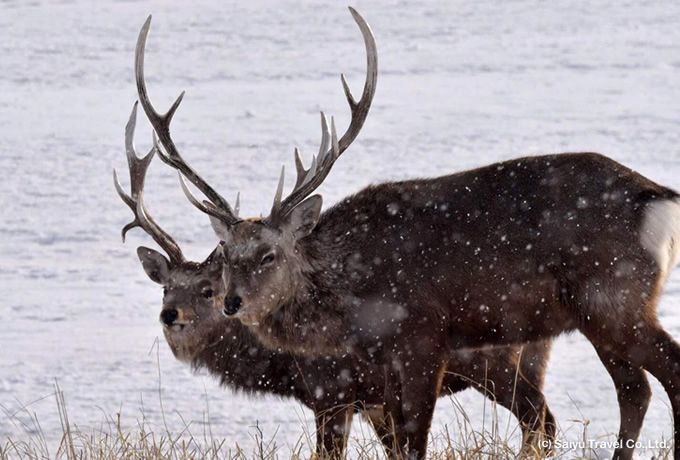 Hokkaido sika deer in winter (March photo)
Hokkaido sika deer in winter (March photo)From March to April, the Hokkaido sika deer will face the most physically demanding time even though it is just at the start of spring. It is because during this period when grass has not yet sprouted, but the deer's energy stores have started to run out, causing many deer to starve to death. This is also the season that male deer antlers start to fall off and regenerate for the next mating season. The new growth of antlers are called "velvet antlers" and are still soft, wrapped in velvety skin that allows blood vessels to feed the growing antlers. These antlers will grow to over 60 cm in about 4 months, into the summer. Then in the autumn, they harden into the familiar tree branch-like antlers called "hard/dry/dead antlers".
As the snow melts, and the new shoots of grass return to the fields, the does can slowly recover their condition towards the birthing season around June. Once it is born, the Sika calf instinctively stays still hidden in tall grass or a bush, where it is difficult for predators to find it. After about two weeks old, the claves can begin to move around with its mother.
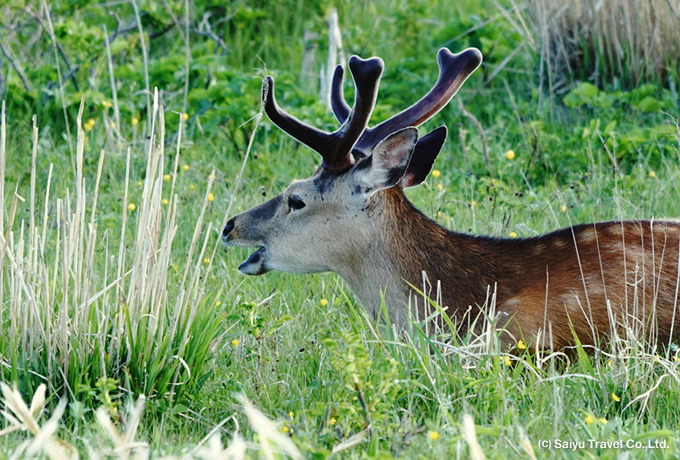 During this season, velvet antlers (June photo)
During this season, velvet antlers (June photo)Autumn is the best season for observing the Hokkaido sika deer. Now that the velvet has come off, the antlers are hardened and ready. During mating season, alpha stags will have multiple does forming a herd called a ‘harem'. The males are constantly competing for the female's attention by rutting, the stags colliding antlers, and trumpeting their calls out into the air.
When a male stag gets sexually aroused, he makes an interesting expression called "flehmen." This expression also common in horses and in Japanese is often referred to as "a horse's laughter." So you can imagine the expression of a "sika deer laughing" if you have not seen it before!
Males also wear quite a unique ‘cologne' to appeal to the females. They will lie down and bathe in the mud that they just urinated in. Getting down in the "wallow" and smearing this urine-soaked mud all over themselves, seems to be the best look for male sika deer stags.
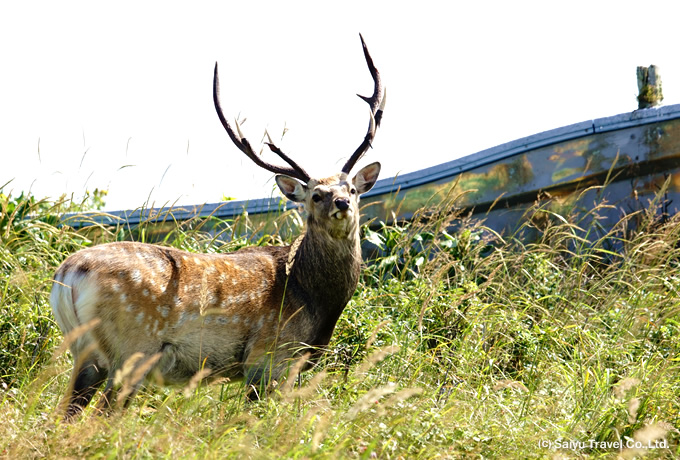 The autumn's hard antlers after the velvet is gone (August photo)
The autumn's hard antlers after the velvet is gone (August photo)

| Species Name | Subspecies of Red fox, Sakhalin fox |
| Japanese Name | Akagitsune / Kitakitsune |
| Scientific Name | Vulpes Vulpes schrencki |
| Height | 60 - 80cm |
| Weight | Male 5 - 6kg, Female 4 - 5kg |
| Distribution | Hokkaido, especially common across Eastern Hokkaido |
This is a subspecies of the red fox which is widely distributed across Hokkaido. Next to the Hokkaido sika deer, this is the second most likely wildlife you will see commonly as you travel. Since 1994, they almost disappeared due to a horrible outbreak of scabies (caused by Sarcoptes scabiei, a parasitic mite) but in recent years, the population has finally recovered. Once a year they regrow their hair completely. In the summer the fur is short and makes them look thin but in the winter, they transform into fluffy cute foxes. Breeding season for foxes starts in January to February and will give birth to 3 to 6 offspring in the early spring.
Foxes live in a family unit while maintaining a territory. If you observe carefully, you will be lucky to catch them wandering around marking certain areas, or listening and jumping to catch mice and snakes. They are omnivorous with a very wide range, eating small animals such as wild mice or voles, to fruits and plant-based foods. Especially in the autumn fields, there are many delicious fruits such as Hardy kiwi (Sarunashi) and beach rose hip (hamanasu). These are said to be the favorites for young foxes who haven't yet mastered the art of hunting.
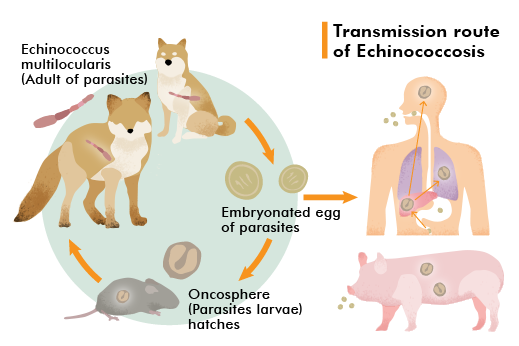
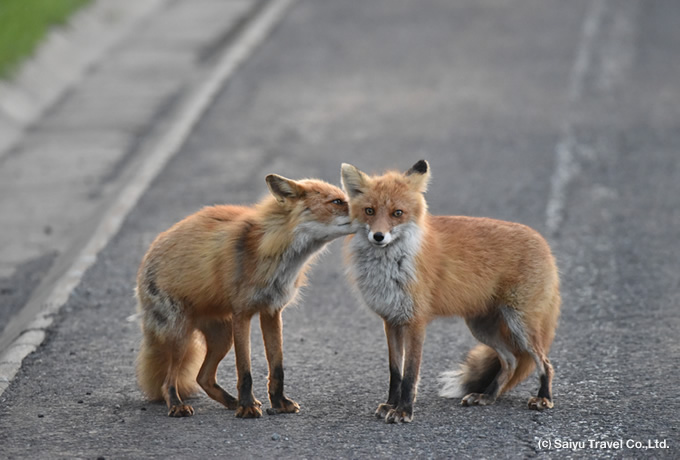
Foxes that have eaten infected mice can be victims of the Echinococcus tapeworm. When a tapeworm egg is laid in the fox's intestine, it is excreted with the dung, and traveling through the swamp water, can be accidentally ingested, infecting human hosts causing ‘hydatid disease.' In people, if the parasites settle in the liver, it can cause delayed symptoms in adults, only showing more than a dozen years later. In children, the symptoms tend to show more quickly. In the worst case scenario, there is a risk of death, without treatment. Foxes are carriers but do not die when infected with Echinococcus. In recent years, the likelihood of infected foxes in Hokkaido continues to increase, and prevention measures against the parasites are required. The preventative measures you can take are:
1. Do not drink unfiltered/untreated water or unwashed wild plants
2. Wash your hands properly after coming in from outside or touching your muddy gear.
3. Do not feed wild foxes and do not encourage them to come into areas with frequent human activities.
4. Avoid coming into direct contact with foxes, etc.
Many people simply think “I just want to get a little closer for a photo” or they may want to try to feed it, but this is exactly what is the ‘Bad behavior.' Not only is there a risk of hydatid disease for the people, but the foxes will remember the taste of human food and be attracted to the road to look for handouts, and they could get hit by a car.


| Species Name | Subspecies of Red squirrel, Ezo / Hokkaido squirrel |
| Japanese Name | Kitarisu / Ezorisu |
| Scientific Name | Sciurus vulgaris orientis |
| Height | 22 - 27cm |
| Weight | 300 - 470g |
| Distribution | All around Hokkaido |
Eating many things such as seeds, buds, flowers, and the sap of trees, as well as insects. Most active around noon, but even active in the middle of winter, starting 2 - 3 hours after the sunrise. In the autumn, they are busy hiding food all day long in a hectic preparation for winter. They not only use holes in the trees and between the branches, but they also dig holes in the ground and cover it up. During the winter, they will feed on these buried treasures, but in the following year, you might see the seedlings growing from the forgotten acorns and the overlooked Japanese walnuts.
The Hokkaido squirrels do not hibernate in the wintertime and come out to look for food, even in the middle of a snowstorm. Most of the day will be spent sleeping, as they will hunt for food in a short period of two to three hours in the morning, then soon return to their nest to sleep. These short bursts of activity and long periods of sleep is said to be Hokkaido squirrel's strategy to survive the cold winters.





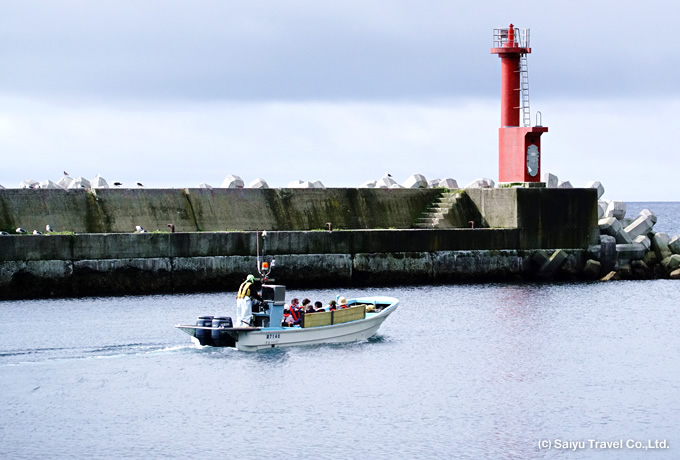 A ferry departing from Aidomari Port
A ferry departing from Aidomari Port 
*These are wild animals, so there are no guarantees of their appearance and changes in weather conditions and the local environment will affect the wild animal's behavior.